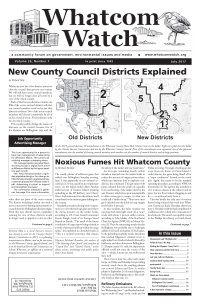by Jamae Pope
To celebrate 26 years of publishing Whatcom Watch, we are printing excerpts from 20 years ago. The below excerpt is from the July 1997 issue of Whatcom Watch.
Americans directly subsidize driving to the tune of $400 billion per year. We’ll take a look at the total being over $700 billion in hidden costs (direct and indirect) that can be attributed to our automobile-based lives. The costs to our health and our environment that are not directly paid by drivers are costs that affect our pocketbooks and our social wellbeing as we pay for ailments, accidents, and environmental degradation.
A growing body of planners, economists and policy makers are arguing that we would drive less and have less urban sprawl if we recognized and accounted for the full costs of driving. The sources of these facts range from the Federal Railroad Administration to the Worldwatch Institute.
Health Costs
We directly bear the health costs of traffic accidents and air pollution when they strike us and our families. Most of us either know someone or have a friend that knows someone who has been killed in a car accident. Traffic accidents kill around 40,000 people in the United States alone each year and severely injure 500,000 more. (This is comparable to a medium-sized war, every year.) We also pay indirectly for the emergency services and health care needed to respond to these traffic accidents.
Air pollution adds to the toll of the indirect health costs that we pay. The news is full of the growing number of asthma cases all over the country. Latex particulates from tire and brake use are large contributors to the increase in asthma in urban and suburban areas. The cost of the damages from motor vehicle air pollution including illnesses and premature death, reduced agricultural productivity, damage to materials, reduced visibility and others, calculate to a conservative estimate of $10 billion per year. (Estimates range up to $200 billion depending on the value assigned to human health and life.)
Environmental Costs
Air pollution is an obvious result of driving (driving cars causes 60 percent of the air pollution), but our environment is more than air. Auto use is also largely responsible for water pollution, loss of open space, and land, forest and crop damage.
The car impacts our environment in all of the stages of its life. Looking beyond operating costs, the production and disposal of cars has a huge impact. A German study calculates each car is responsible for producing 26.5 tons of garbage over its lifetime. The German study also attributes three dead trees and 30 “sick” trees due to acid rain over each car’s lifetime.
Construction of transportation infrastructure destroys wetlands and streams. Up to 75 percent of the land in Los Angeles is paved. Buses and rail cars take up some space, but they are about 50 times more space efficient on the road than cars. And they don’t hang around all day. Thus transit, walking, and bicycling free up urban space for parks, trees and places to hang out that are free of cars.
Buses and trains are also vastly more efficient and less harmful than cars. The average commute by single occupant vehicle consumes about 65,000 BTUs of energy. Going by bus is seven times more efficient, by subway 35 times more efficient, and by train 60 times more efficient. Land use and pollution efficiencies are similarly dramatic. Rail transit can provide the same people-moving capacity as up to as 18 general-purpose freeway lanes. Even a diesel bus emits approximately nine times less carbon monoxide and hydrocarbons per passenger mile than a single occupant vehicle.
In the next section we will sum up all of the true costs of driving (personal, social, health and environmental) to show how heavily subsidized our automobile habit is. The total of all these costs has been estimated to be at least $700 billion per year. Some estimates put it much higher. Whatever the cost, it is too high. Our goal in this article is to create an awareness that affects our personal choices as well as the choices our leaders make.
The auto problem is about pollution, is about energy waste, and is about a bad investment of our transportation dollars, but is also about our health and our quality of life. When we realize that the number of deaths and injuries due to traffic accidents is comparable to a medium sized war — every year — we start to wonder why we aren’t picketing for more alternatives to driving. Perhaps adding up all the costs will make us mad enough to do something about it.
____________________________________
At the time this article was written Jamae Pope was communications director for ALT-TRANS (Washing-ton Coalition for Transportation Alternatives).




























